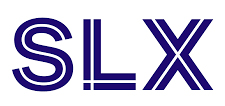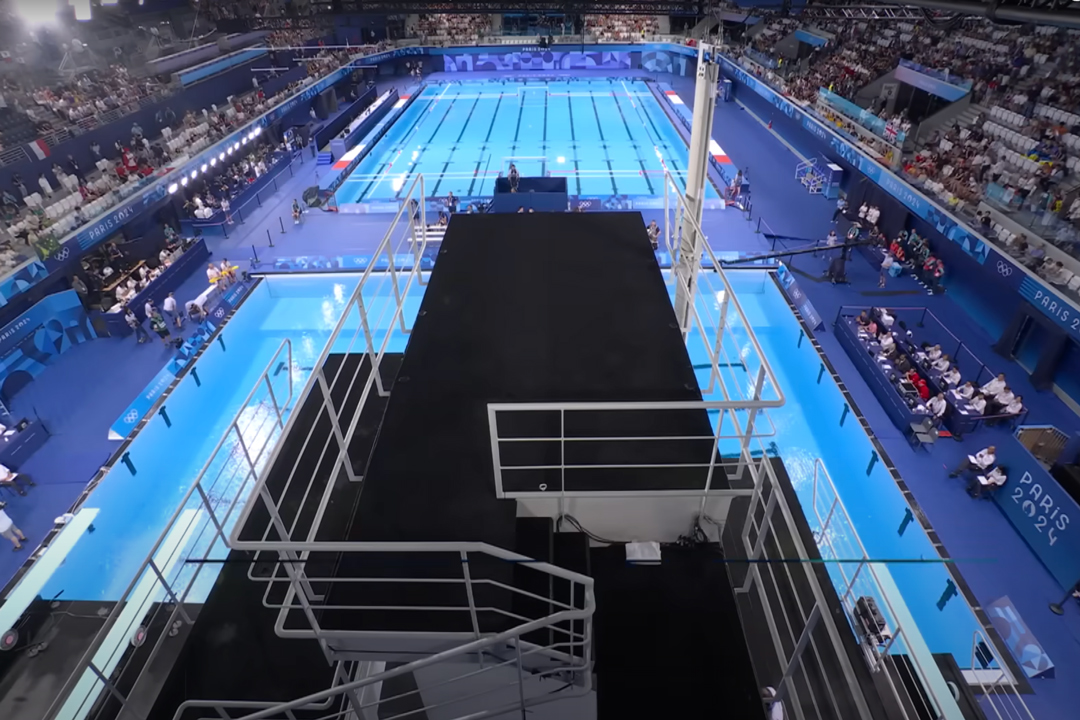SLX, a service provider based in the United Kingdom, won the tender for the lighting of the Olympic events which took place in the brand-new Olympic Aquatics Center (CAO). Its CEO Alastair Currie and Russell Payne, Managing Director, explain their approach to meeting the demanding specifications.

On-site on June 3, I discovered a magnificent space dedicated to sport. It will be inaugurated with diving, artistic/synchronized swimming, and water polo events. The workers are putting the finishing touches on this gigantic project. It is the only sports infrastructure built for the Olympics and then preserved. Its total cost of 175 million euros will have been paid for by public funds.
I met up with Patricia Attar, press agent; Alastair Currie, CEO of SLX; and Russell Payne, its managing director, so they could tell me all about their approach to the project. The construction site having started at the end of 2021, SLX will not begin work until January 2023, which is quite late compared to other projects of this scale, says Russell Payne.
The lighting market for the Paris 2024 Olympic Games

The SLX company has already delivered three Commonwealth Games in Birmingham in 2022 by providing rigging, broadcast lighting, as well as lighting linked to the spectator experience (animation, prize giving).
They also worked on the European Championships and were therefore in first place to respond to the call for tenders for the Paris 2024 games.
Alastair Currie : “The Paris 2024 team asked us to apply for the call for tenders to become the official provider of sports lighting and broadcast lighting for venues in the Paris region.
We were chosen in January 2023 and are in charge of the Stade de France, the Vélodrome, and the BMX stadium in Saint-Quentin-en-Yvelines as well as the Olympic Aquatic Center in Paris.”
SLU : What is SLX’s approach to lighting the Olympic events?
Alastair Currie : “We seek to create an atmosphere and environment suitable for the media partners working on the Games, spectators, and athletes. We also try to add sparkle to bring more life to these moments.”

SLU : Have you made any investments in lighting equipment for these Olympics?
Alastair Currie : “Indeed, we wanted to ensure we had access to the best quality light to guarantee the Broadcast crews that every image captured and broadcast to a phone, TV screen or large LED screen is flicker-free, reflections or, potential shadows and therefore to provide very clear visibility to everyone.
The other aspect of our investments is sustainability with a guarantee that the fixtures can be used over a long period to benefit from them in the long term but also ensuring that they can then be recycled or resold on the second-hand market. These points, i.e. the design, technical aspects, and durability of the products, have been the subject of in-depth consideration”.
SLU : The Aquatics Center is a bit special because it will be inaugurated with the Olympics. Are the installations you have done intended to remain after the events?
Alastair Currie : “Lighting with older fixtures had already been planned when we started our setup. So we implemented what we call an “overlay” to make it suitable for broadcast. The basic lighting is therefore intended to remain on site but our equipment will leave for the next shows and events in which SLX will intervene.”
SLX is an English company founded in 1979 and based in Bristol. Over time, the service provider has been able to build a solid, passionate, and competent team, which strives, as here for this new challenge of the Olympic Games, to create lighting that meets the demands of athletes, the Broadcast crew, and spectators. For the Paris 2024 Olympic Games, they are only bringing lighting solutions however they are also capable of meeting audio and visual specifications.
The service provider is also one of the companies holding B Corp accreditation guaranteeing a rigorous evaluation of objectives and achievements from the point of view of sustainability and social values. The teams work within a specific framework aimed at creating low-carbon emitting events.
In July 2023, a subsidiary opened in France, SLX France, following the contract signed for Paris 2024. CEO Alastair Currie explains “This branch allowed us in the short term to make the delivery for the games more efficient. In the medium to long term, we will probably want to stay in Europe to cater to other markets.
Being in Paris or the Paris region is an excellent way to access other areas linked to our activity and we also hope to be able to intervene in the Winter Olympics in Milan in 2026 which would mean that we would be in Europe for several more years. So this is a strategic decision that I hope will allow the company to grow.”
3D modeling and IES files
IES (Illuminating Engineering Society) files contain spatial light distribution data, otherwise known as luminaire photometric curves. This data is provided by many manufacturers so that lighting designers can realistically simulate how a project will look when a light source is used. Here they were used by the SLX technical team to check the effectiveness of the lighting kits beforehand.

Russell Payne : “To design the lighting we modeled the venue in 3D, then taking into account the reflective properties of the water, the IES files allow our simulation software to indicate the lighting levels in lux on the different “playing fields”.
We thus have the flow in each zone to determine how it works for the human eye but also for 4K cameras. We therefore ensure that the lighting is correct in all three dimensions.”

Russell Payne : “We need to achieve a minimum of 1600 lux and our software proves we can do this with our equipment. When we submit our projects, we include the calculations from this software.
They can thus see that we reach the required level uniformly across the “Field of Play”. However, from a design perspective, it’s up to us.
For example, here, in the diving event area, we created a model of the athletes when they are standing and finally installed two backlights on the 10-meter board, one on each side. One of them diffuses at 40° and the other at 20°, that is to say with a wider backlight on one side and more intense on the other. In my opinion, we are ultimately in a theatrical process which consists of understanding how light works and what we need to do to see people correctly, then we add the cameras.”

Russell Payne Russell Payne comes from stage lighting in the theater but he also worked in the field of events and live performances before becoming interested in lighting for sports. “I still do a lot of other events and a bit of theater but sporting events are our biggest projects.»
Russell Payne : « You never forget that you are responsible for lighting the biggest moment of someone’s life. Athletes have trained all their lives to reach the top of their discipline. We have no right to fail them.»
Lighting up an Olympic venue with/for television coverage
Russell Payne : “Mostly European manufacturers supplied us with the equipment. A large number of automated fixtures are Ayrtons. The manufacturer is based here in Ile-De-France, and their equipment will cover a large part of the sporting events. But we also use Italian Claypaky floodlights as well as our products which are very specific sports lighting panels developed in-house by SLX and designed to meet the needs of Olympic Broadcasting Services (OBS).”
SLU : What were the main demands of the OBS specifications?
Russell Payne : “I think as the Olympics try to expand their audience, people consume media in different ways. They can watch them on their phone, tablet, or television.
The lighting requirements to ensure image quality when moving from one sport to another are ultimately the same and one must use the same light sources and design philosophy throughout the process.
This is especially important when daylight falls and we move from one location to another so that the director’s cuts are not noticed when he moves from one event to another.”

SLU : And at the Olympic Aquatics Center site, what are the needs?
Russell Payne : “Broadcast teams are using faster and faster cameras to achieve effects like super slow motion for the swimming and so on. For our part, we must therefore ensure that there is no flicker in the image. The color temperature is also very important because we are aligned with 5700 kelvins for all events so that they are all compatible.”
SLU : Were there any specifics to consider in the position and rigging angles of your kit?
Russell Payne : “We light for three different audiences: the paying audience, the cameras, and the athletes for whom this moment is extremely important. For example, if at the top of the diving board, the athlete has the light in his eyes, he is bothered by it.
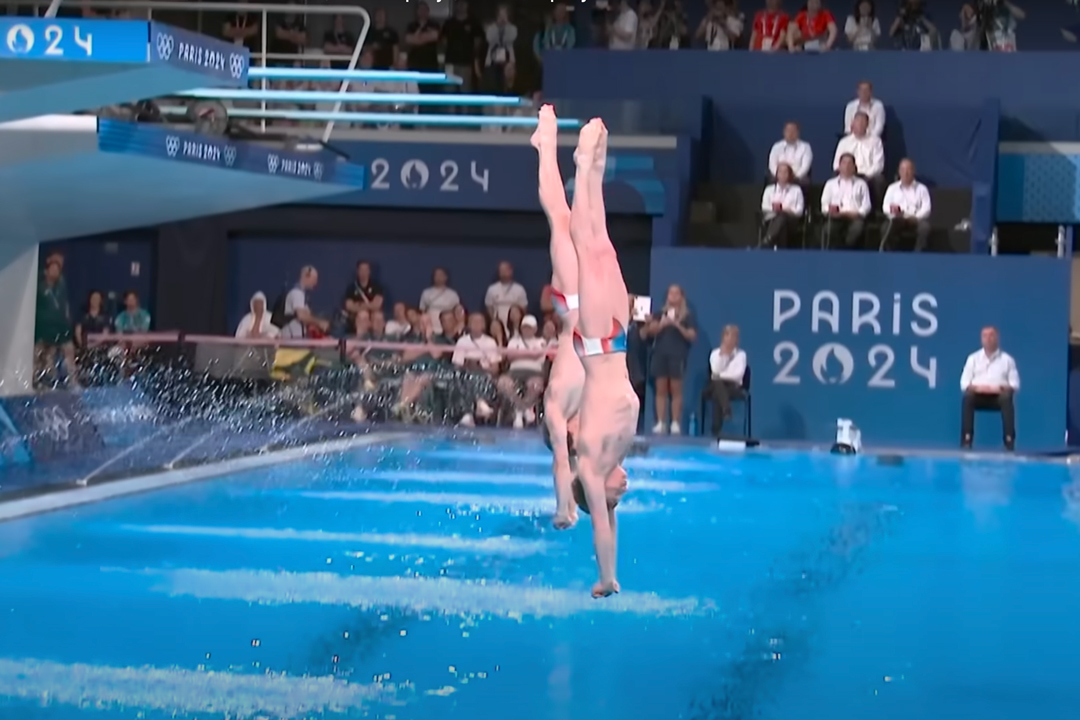
Then there are rules governing the level of Broadcast lighting for the cameras and finally, there is lighting for the audience. Meeting these three regulations requires some detailed work, particularly when it comes to large bodies of water where reflections must also be avoided.”
SLU : What was your approach to achieving this?
Russell Payne : “We hung blue curtains that help cut out the reflections on the water. The pool therefore seems lit, but we cannot see any light source. It is at this level of detail that we must work and mathematically calculate the height at which the camera field is located as well as the different viewing angles.
Here the lighting takes into account the cable camera which moves over a wide area at an intermediate level with the light kit and the pools. We would have liked to have lighting at this level but it was not possible.”


SLU : Is shade/shadows also a problem in these pool events?
Russell Payne : “This should be taken into account in Artistic/Synchronized Swimming at the start of the routine when the swimmers come out of the water and they need to be very well lit because they strike a pose before entering the water. The same goes for water polo events where players line up along the edge of the pool before diving in and where it is necessary to ensure that the lighting is adequate.”
Ayrton Rivale and Claypaky Arolla Aqua Profile capable of the impossible in an aquatic environment
The “Field of Play” concerns two pools (one of 50 × 25 m, and a diving pool of 22.20 × 25 m) and benefits from a completely IP 65 kit. A necessity in this particularly humid place. The spotlights are put to the test during this summer period.
Russell Payne : “There was a high technical requirement before our fixtures were installed. Not only have the fixtures been tested in a humid environment, but we have also frozen them to be sure that they are capable of operating at -30° for a month. We also carried out water penetration tests. All of this was done on prototype units before they were ordered.
With such a large number of fixtures in production, with the Olympics as a deadline, we could not allow them to break down. Having already worked on three Commonwealth Games and European Championships, although these were our first Olympic Games we had this level of experience and understanding of the requirements which allowed us to position ourselves well on the Olympic Aquatics Center site.”

SLU : Why did you specify white source fixtures?
Russell Payne : “In sports lighting they allow you to obtain maximum light and make the most of the LEDs in the fixture. Lighting in sports is very strict on the fact that all athletes can compete under the same conditions.”
SLU : Are you happy with the Ayrton Rivale?
Russell Payne : “We chose the Ayrton Rivale because they are IP65 certified. They are installed on trusses in the audience. We also use the Cobra at the Stade de France for its laser source. We are big fans of Ayrton. As a supplier, we have a large stock of their products including Rivale, Diablo, Cobra, and Eurus. We have built a very good working relationship with Ayrton and I think they have been able to offer a very interesting range at the right time.”
With the Rivale, Ayrton has put on the market a versatile and tailor-made fixture for service providers. It produces a flow of 35,000 lumens thanks to a new generation 450-watt white LED matrix (at 6500 K). The trichrome + CTO system is made up of 4 flags whose large surface gives great precision in the gradation of colors. Its zoom range extends from 4° to 52° for a magnificent ultra-wide beam. The fixture is compact and light (28 kg) but offers an ultra-complete range of functions because it is optimized. The icing on the cake is that it is rated IP65 and benefits from continuous pan and tilt rotation.
SLU : You also chose the Claypaky Arolla Aqua profile fixtures…
Russell Payne : “We’re very committed to quality because we can’t go back in time and it has to work for months. So we needed a product that we were sure would work smoothly and was made by a reliable manufacturer and that was the case with the Claypaky Arolla Aqua.”
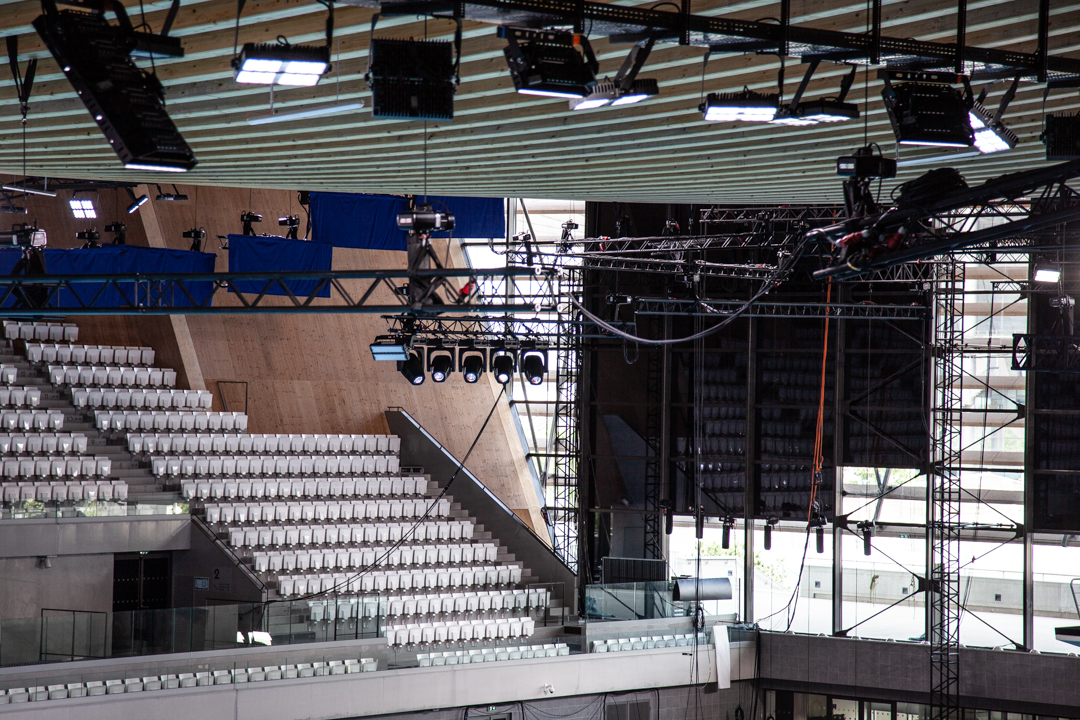
Classified IP65, Spot/Profile fixtures from the Arolla range also meet the expectations of a large number of service providers. The size, weight, and flux ratio of 22,000 lm is impressive. The zoom aperture range, 6 – 50°, is very wide for a fixture of this size. With a 590mm high and 360mm wide base unit (including handles) and a weight of no more than 24kg!
Russell Payne : The Aqua Arollas give a little more definition to the lower part of the pool. Regarding the diving event, the part that we want to light is invisible but the part that constitutes the jump is lit the same way throughout the descent so that the cameras can follow the diver all the way down.”

This vertical corridor is lit by floodlights from the SLX Sports brand, developed in 250W, 500W, and 1.5kW versions to obtain a very large quantity of pure white light.

SLU : What is your control system?
Russell Payne : Russell Payne: “We use Grand MA 3 Soft 3s for all games. What is difficult here is that we control the fixtures in DMX, but the lighting in the room is controlled with DALI. It is an architectural control system. So, we also had to design a system that allows our DMX console to communicate with the DALI console.
The problem is that the building is equipped with control software, and if it detects that someone is trying to control the lighting, which it analyzes as a problem, it controls the switching on of all emergency lights, fire alarms, etc. To bypass building security we have therefore developed an interface that allows us to activate and deactivate circuit blocks individually. This makes it almost possible to bypass this control system.”
An Interview area lit by Chauvet Professional onAir

Chauvet Professional onAir Panel 1 IP and onAir Panel 2 IP are IP65-certified RGB LED fixtures with diffused light in 1×1 and 1×2 format.

They are capable of producing 10,000 and 20,000 lumens respectively and their color temperature is adjustable from 2800K to 8000K, with a high CRI of up to 95, an illuminance of 165 lux @ 5 m for the 1 IP, and 350 lux for the 2 IP, a projection angle of 100°, +/- green adjustment and red-shift emulation.
In addition to protocols, DMX-RDM, Art-Net, sACN, and a CRMX receiver. A 28 VDC input on XLR 3 allows these fixtures to be powered from an external battery for more flexibility.
The Stade de France, a different type of challenge

SLU : I know that you also have the Stade de France site. What are the issues/constraints?
Russell Payne : “At the Stade de France there are thousands of floodlights lighting up a huge number of different sports, as all the events take place on the same pitch. In addition, there is athletics but also rugby at the start of the Olympics. So it’s a very large number of fixtures and you have to make sure that each of them works properly without affecting the cameras, cable cameras, or other sports during athletics events. A discus throw can take place at the same time as a running race. So it’s quite complicated, especially since the positions of the cameras can change and so you always have to recheck everything (laughing).”
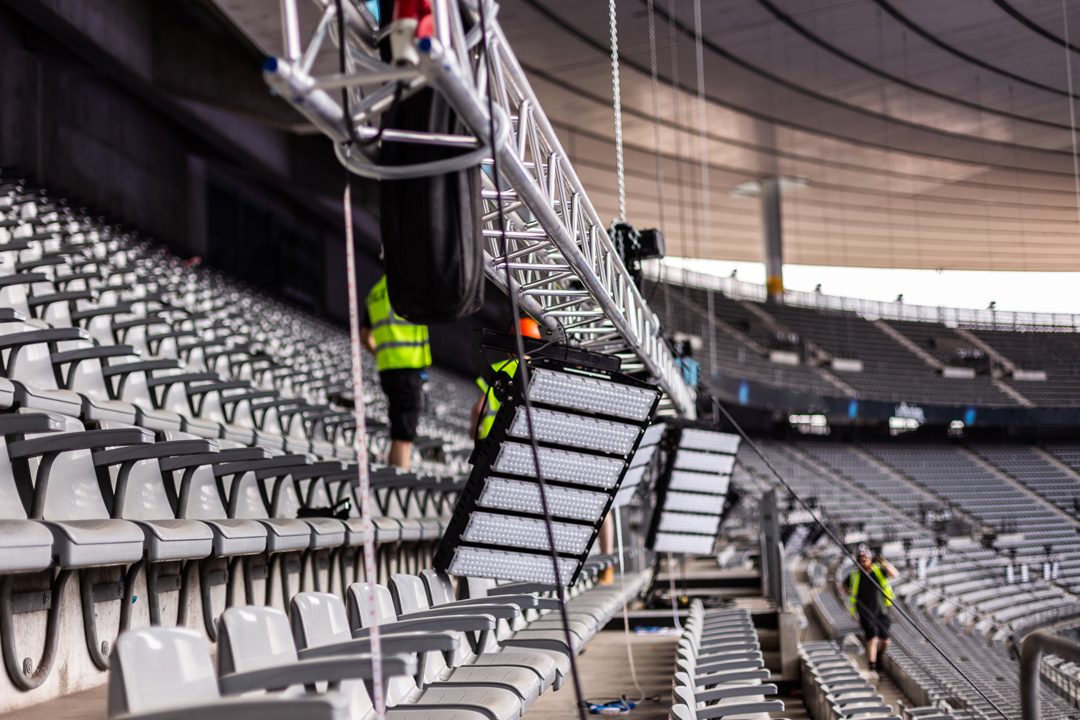
With extensive experience in the field of sports lighting and particularly for world-renowned competitions, the SLX company, led by its President and CEO Alastair Currie, was able to brilliantly respond to the specifications imposed by the ‘OBS.
Their choice of equipment was made without compromise to ensure the maintenance of a lighting kit over the long term, and without technical concerns, above the pools of the Olympic Aquatic Center in Paris.
Ayrton Rivale and Claypaky Arolla Aqua have been carefully selected. They are accompanied by fixtures developed by SLX to produce balanced lighting on the Field of Play following very in-depth work carried out upstream with IES files.
On-site, and so as not to blind the athletes, the audience, or the cameras, Russell Payne and his technical team installed a small curtain for fine and precise lighting that does not interfere with the recording and/or broadcast.
The Chauvet Professional onAir panels take over following the events to collect the first words of the Olympic medalists in Water Polo, diving, and, artistic/synchronized swimming in front of the journalists/press.
A heartfelt congratulations to all the professionals who managed to turn these sporting events into unforgettable Olympic moments.



